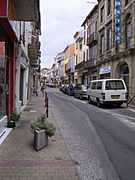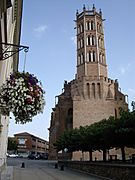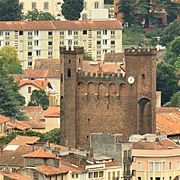Pamiers facts for kids
Quick facts for kids
Pamiers
|
||
|---|---|---|
|
Subprefecture and commune
|
||
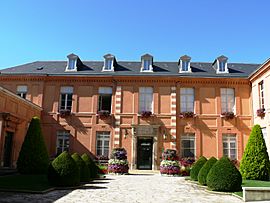
Pamiers: City Hall
|
||
|
||
| Country | France | |
| Region | Occitanie | |
| Department | Ariège | |
| Arrondissement | Pamiers | |
| Canton | Pamiers-1 Pamiers-2 |
|
| Intercommunality | Les Portes d'Ariège - Pyrénées | |
| Area
1
|
45.85 km2 (17.70 sq mi) | |
| Population
(2014)
|
15,518 | |
| • Density | 338.45/km2 (876.59/sq mi) | |
| Demonym(s) | Appaméens | |
| Time zone | UTC+01:00 (CET) | |
| • Summer (DST) | UTC+02:00 (CEST) | |
| INSEE/Postal code |
09225 /09100
|
|
| Elevation | 256–473 m (840–1,552 ft) (avg. 365 m or 1,198 ft) |
|
| Website | www.ville-pamiers.fr | |
| 1 French Land Register data, which excludes lakes, ponds, glaciers > 1 km2 (0.386 sq mi or 247 acres) and river estuaries. | ||
Pamiers (Occitan: Pàmias) is a commune in the Ariège department in the Occitanie region in southwestern France. It is a subprefecture of the department. Although Pamiers is the largest city in Ariège, the capital is Foix, a smaller city.
Contents
History
In 1111, the city was officially founded by the Count Roger II of Foix and the abbot of the of Saint Antonin of Pamiers; they built a castle (now demolished) and named it Castrum Appamiae, after a Syrian city, Apamea, that was visited by Roger II during the First Crusade. A church was built at the foot of the castle (Our Lady of Mercadal) where is now the cathedral.
Geography
The city of Pamiers is along the Ariège river in the plain formed by this river in the northern part of the Ariège department, in southern France.
The commune has an area of 45.9 km2 (17.7 sq mi). Its average altitude is 365 m (1,198 ft); at the city hall, the altitude is 295 m (968 ft).
Pamiers is at 64 km (40 mi) to the south of Toulouse, 20 km (12 mi) to the north of Foix and 53 km (33 mi) to the west of Saint-Girons.
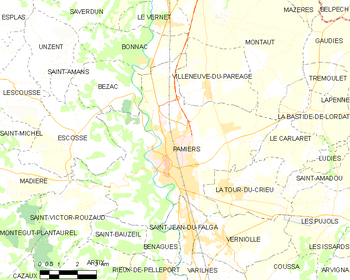 |
The commune of Pamiers is surrounded by the communes:
 |
Bézac | Bonnac and Villeneuve-du-Paréage | Montaut |  |
| Escosse and Madière | Le Carlaret and La Tour-du-Crieu | |||
| Saint-Bauzeil and Saint-Victor-Rouzaud | Saint-Jean-du-Falga and Benagues | Verniolle |
Climate
The climate of Pamiers, in the Köppen climate classification, is Cfb - Oceanic climate with template summers.
Population
The inhabitants of Pamiers are known, in French, as Appaméens (women: Appaméennes).
With a population of 15,518, Pamiers is the city in the department with more people living in it; its population density is of 338 inhabitants/km2.
Evolution of the population in Pamiers
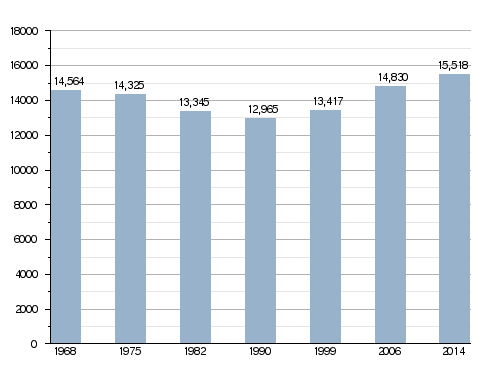
Pamiers forms, with other 6 communes, the urban area of Pamiers with a population of 26,727 inhabitants (2013) and an area of 91.7 km2 (35.4 sq mi). This urban area is the centre of the metropolitan area of Pamiers, formed by 29 communes with a population of 35,054 inhabitants (2013) and an area of 256.7 km2 (99.1 sq mi).
Administration
Pamiers is a subprefecture of the Ariège department, the capital of the arrondissement of Pamiers and the administrative centre (French: chef-lieu) of two cantons:
- Pamiers-1, with 12,332 inhabitants (2014).
- Pamiers-2, with 14,702 inhabitants (2014).
It is part of the intercommunality Les Portes d'Ariège - Pyrénées (French: Communauté de communes des Portes d'Ariège - Pyrénées).
Twinned and partner towns
Pamiers is twinned with:
- Gabriel Fauré, (1845-1924), composer
- Pope Benedict XII, (ca. 1280-1342), bishop of Pamiers in the 1320s
Gallery
-
Saint Antonin of Pamiers cathedral
Related pages
Images for kids
See also
 In Spanish: Pamiers para niños
In Spanish: Pamiers para niños





